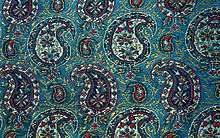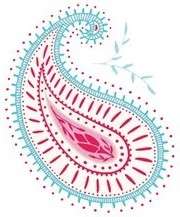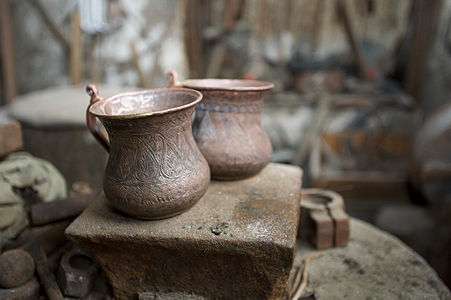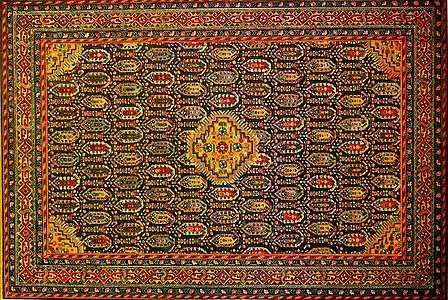Paisley (design)
Paisley or paisley pattern is an ornamental design using the buta (Persian: بته) or boteh, a teardrop-shaped motif with a curved upper end. Of Persian origin,[1] paisley designs became very popular in the West in the 18th and 19th centuries, following imports of post-Mughal Empire versions of the design from India, especially in the form of Kashmir shawls, and were then imitated locally. Although the fig- or almond-like form is of Persian origin, its English name derives from the town of Paisley, in the West of Scotland, a centre for textiles where paisley designs were produced.[2]

The pattern is still commonly seen in Britain and other English-speaking countries on men's ties but remains popular in other items of clothing in Iran and South and Central Asian countries.
Origins

Some design scholars believe the buta is the convergence of a stylized floral spray and a cypress tree: a Zoroastrian symbol of life and eternity.[3] The "bent" cedar is also the sign of strength and resistance but modesty. The floral motif was originated in the Sassanid dynasty and later in the Safavid dynasty of Persia (1501–1736), and was a major textile pattern in Iran during the Qajar and Pahlavi dynasties. In these periods, the pattern was used to decorate royal regalia, crowns, and court garments, as well as textiles used by the general population.
European introduction
Imports from the East India Company in the first half of the 17th century made paisley and other Indian patterns popular, and the Company was unable to import enough to meet the demand. It was popular in the Baltic states between 1700 and 1800 and was thought to be used as a protective charm to ward off evil demons.
Local manufacturers in Marseilles began to mass-produce the patterns via early textile printing processes at 1640. England, circa 1670, and Holland, in 1678, soon followed. This, in turn, provided Europe's weavers with more competition than they could bear, and the production and import of printed paisley was forbidden in France by royal decree from 1686 to 1759. However, enforcement near the end of that period was lax, and France had its own printed textile manufacturing industry in place as early at 1746 in some locales. Paisley was not the only design produced by French textile printers; the demand for paisley which created the industry there also made possible production of native patterns such as toile de Jouy.[4]
In the 19th century, European production of paisley increased, particularly in the Scottish town from which the pattern takes its modern name. Soldiers returning from the colonies brought home cashmere wool shawls from India, and the East India Company imported more. The design was copied from the costly silk and wool Kashmir shawls and adapted first for use on handlooms, and, after 1820,[5] on Jacquard looms.
From roughly 1800 to 1850, the weavers of the town of Paisley in Renfrewshire, Scotland, became the foremost producers of Paisley shawls. Unique additions to their hand-looms and Jacquard looms allowed them to work in five colors when most weavers were producing paisley using only two.[5] The design became known as the Paisley pattern. By 1860, Paisley could produce shawls with 15 colors, which was still only a quarter of the colors in the multicolor paisleys then still being imported from Kashmir.[5] In addition to the loom-woven fabric, the town of Paisley became a major site for the manufacture of printed cotton and wool in the 19th century, according to the Paisley Museum and Art Galleries.[6] The paisley pattern was being printed, rather than woven, onto other textiles, including cotton squares which were the precursors of the modern bandanna. Printed paisley was cheaper than the costly woven paisley and this added to its popularity. The key places of printing paisley were Britain and the Alsace region of France.[7]
Continued use in Asia

The motifs can still be found on Persian carpets, Azerbaijani rugs, kalaghai shawls and textiles, paintings of decorative-applied arts of Greater Iran (Iran, Azarbaijan, etc) and also in decorations of architectural monuments. It is widespread in Ganja, Azerbaijan, where it has been an integral part of carpet ornaments.[8]
It is woven using gold or silver threads on silk or other high quality textiles for gifts, for weddings and special occasions. In Iran and Uzbekistan, its use goes beyond clothing, with paintings, jewelry, frescoes, curtains, tablecloths, quilts, carpets, garden landscaping, and pottery also sporting the buta design. In Uzbekistan the most frequently found item featuring the design is the traditional doʻppi caps.
In Tamil Nadu the manga maalai (mango necklace)[9][10] with matching earrings is a traditional feature of bharathanatyam dance.[11] It is a prominent design in Kanchipuram saris.[12][13][14][15] It has sometimes been associated with Hinduism.[16]
At the 2010 Winter Olympics, Azerbaijan's team sported colorful paisley trousers.[17] It was the emblem of the 2012 FIFA U-17 Women's World Cup, held in Azerbaijan.
Contemporary style
Paisley became identified with psychedelic style due to a resurgence in the pattern's mainstream popularity leading up the mid- and late 1960s, partly due to The Beatles. [18] Consequently, the style was particularly popular during the Summer of Love in 1967. The company Fender made a pink paisley version of their Telecaster guitar, by sticking paisley wallpaper onto the guitar bodies.[19][20] Prince paid tribute to the rock and roll history of paisley when he created the Paisley Park Records recording label and established Paisley Park Studios, both named after his 1985 song "Paisley Park".
Paisley was a favorite design element of British-Indian architect Laurie Baker. He has made numerous drawings and collages of what he called "mango designs". [21] He used to include the shape in the buildings he designed also.[22]

In other languages
The modern French words for paisley are boteh, cachemire ("cashmere"; not capitalized, which would mean "Kashmir, the region") and palme ("palm", which – along with the pine and the cypress – is one of the traditional botanical motifs thought to have influenced the shape of the paisley element as it is now known).[3][23]
In various languages of India and Pakistan, the design's name is related to the word for mango:[24]
- In Bengali: kalka[25]
- In Andhra: mamidi pinde', young mango pattern
- In Tamil: mankolam, mango pattern
- In Marathi: koyari, mango seed
- In Hindi/Urdu: carrey or kerii, means unripe mango[26]
- In Punjabi: ambi, from amb, mango.
In Chinese, it is known as the "ham hock pattern" (火腿纹 huotuiwen).[27] In Russia, this ornament is known as "cucumbers" (огурцы).[28][29]
Gallery
References
- ↑ Review of Textile Progress. 8. Textile Institute. 1956. p. 257.
The so-called "Paisley" pattern, therefore, is a direct copy of the Indian Pine Cone motif, which was, in turn, of Persian origin.
- ↑ English Dictionary, Oxford .
- 1 2 Indian Hand Woven Jacquard Jamavar Shawls, Zanzibar Trading .
- ↑ "The Prohibition Years, 1686–1759", Le Musée de l'Impression sur Etoffes [The Museum of Printed Textiles], retrieved February 3, 2008 .
- 1 2 3 Andrews, Meg, Beyond the Fringe: Shawls of Paisley Design, Victoriana, retrieved February 3, 2008 . Heavily illustrated history of paisley fashions.
- ↑ "Paisley Museum and Art Gallery", About Britain .
- ↑ "Printed 'Paisley' in the 19th Century", Le Musée de l'Impression sur Etoffes [The Museum of Printed Textiles], retrieved February 3, 2008 .
- ↑ Н. Самгнна. (1995). Ковры типа Фахралы. 56. Сообщения Государственного Эрмитажа: Искусство. p. 59.
- ↑ "22Kt gold Mango Mala necklace from India on Jewel of the Lotus". Asian art. Archived from the original on 2013-06-25. Retrieved 2013-03-11.
- ↑ "Traditional Jewels of India". Jewels in India. Retrieved 2013-03-11.
- ↑ "Blue stones Mango Necklace Temple Bharatanatyam Jewelry". Vadaamalar. 2011-01-08. Retrieved 2013-03-11.
- ↑ Sarumathi, K (2012-08-12). "M.S. blue, mango motif still in vogue". The Hindu. Retrieved 2013-03-11.
- ↑ Trends, Desi (2012-06-15). "Jayapradha Red Kancheepuram Bridal Sari | Saree Blouse Patterns". Celebrity saree. Retrieved 2013-03-11.
- ↑ "Image 14620652". Kanchipuram Silk Saree Stock Photography. Dreams time. 2010-04-24. Retrieved 2013-03-11.
- ↑ "Sareeslook sarees". Picasa Web Albums. Google. 2009-11-13. Archived from the original on 2013-01-24. Retrieved 2013-03-11.
- ↑ "Image of the Mankolam Design". Sacred Symbols of Hinduism. About. 2012-04-10. Retrieved 2013-03-11.
- ↑ "Vancouver 2010: The Olympics of the Silly Pants", Tonic .
- ↑ http://www.bbc.com/culture/story/20151021-paisley-behind-rocks-favourite-fashion
- ↑ http://www.tdpri.com/wp-tdpri/resources/paisley-teles/
- ↑ https://www.premierguitar.com/articles/1968_Fender_Paisley_Telecaster_and_Telecaster_Bass
- ↑ "Archived copy". Archived from the original on 2016-03-04. Retrieved 2016-01-09.
- ↑ http://www.livemint.com/Leisure/djP08vKPt2lHkjsInYkItN/The-mango-house.html
- ↑ Sharon B (Aug 29, 2006), A prune or a pickle: the process of working up a small design, Wordpress, retrieved February 3, 2008 .
- ↑ "Paisley Pattern : The ever favourite Fabric Pattern revisited – Sew Guide". Sew Guide. Retrieved 2018-02-01.
- ↑ Zaman Niaz (1993). The Art of KANTHA Embroidery (Second Revised ed.). Dhaka, Bangladesh: The University Press Limited. p. 82. ISBN 984-05-1228-5.
- ↑ http://forum.wordreference.com/threads/urdu-and-punjabi-kerii.1986455/
- ↑ Baike, Baidu .
- ↑ http://blog.berite.info/Paisley/
- ↑ http://best-guide.ru/?p=6008
Sources
- F. Petri «Origin of the Book of the Dead Angient Egipt». 1926. June part 2 с 41–45
- С. Ашурбейли «Новые изыскания по истории Баку и Девичьей башни» Альманах искусств 1972 г, С.Ашурбейли «О датировке и назначении Гыз галасы в крепости» Элм. 1974 г.
Further reading
- Irwin, John (1973), The Kashmir Shawl, Victoria and Albert Museum, ISBN 0-11-290164-6 .
- Levi-Strauss, Monique (1987), The French Shawls, Dryad, ISBN 0-85219-759-4 .
- Reilly, Valerie (1987), The Paisley Pattern: The Official Illustrated History, Glasgow: Richard Drew, ISBN 0-87905-317-8 .
| Wikimedia Commons has media related to Paisley pattern. |





.svg.png)